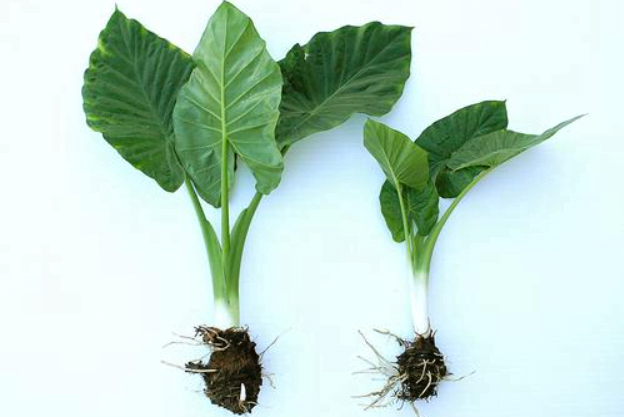Are you looking forward to making some beautiful addition to your elephant ear plant? Or are you new at gardening and want to propagate elephant ear plants? If so, then you have come to the right place because, in this article, I will tell you how to propagate elephant ear leaves which will help you enhance the charm of your garden.
The elephant ear plant is a lush green plant used throughout the world for decorative purposes as it is astonishingly beautiful. Elephant ear is a very fast-growing plant, especially in the summers and spring seasons. If kept under optimum temperature with nutritive soil and humidity, it grows as fast as two feet within a few days, and the leaves will become broader depending upon the quality of the soil.
Contents
- How to Propagate Elephant Ears Plants Easily?
- When to Propagate Elephant Ears Plants and Seasons?
- How to Propagate Elephant Ears Plants?
- Propagation Through Seeds
- Propagation Through Tubers
- Growing of Elephant Ear plant
- Conditions for Growth
- Transplanting
- Seeds
- FAQs
- Can you propagate elephant ears from cuttings?
- How do you take cuttings from elephant ears?
- Do elephant ears spread fast?
- Conclusion
How to Propagate Elephant Ears Plants Easily?
There are basically two methods used for the propagation of elephant ear plants, including seed propagation and tuber propagation. Tuber propagation is used mostly instead of seed propagation as it gives better results. Tuberous clumps are formed in the roots of elephant ear plants which are best for vegetative propagation.
When to Propagate Elephant Ears Plants and Seasons?
Elephant ear plants become dormant in winter, so if you want your plant to grow at the best rate, try to sow it at the end of winter so that you would be able to get a little plant when the spring arrives. If you have Elephant ear corms, try to save them through winters as it is not favorable for them to grow.
In summer, when you see the development of a tuber with a small node for the development of the stem, you can use that after cutting for propagation purposes. The soil of the plant is an important factor as well when you are looking for vegetative propagation.
How to Propagate Elephant Ears Plants?
If you are interested in gardening and want to learn the propagation of the most beautiful and lush green elephant ear leaf plants, don't worry as it isn't a very tough job to do. You can propagate this plant just like various other plants through the healthy tuber. You can do this in the winter when the plant is in a dormant state so that you could be able to get a happy indoor plant for your spring and summer season.
Propagation Through Seeds
Propagation through seed isn't a common method observed and practiced for propagation by Gardners and most people. Well, it isn't impossible, though, as you can propagate through seeds if your elephant ear plant develops a seed pod.
You can collect this seed pod by turning and twisting it off from the plant and then opening it carefully as it will be full of seeds and pulp. Remove the seeds carefully from the pulp and remove the pulp remaining on the seed by rinsing them off through freshwater. Make sure to collect enough seedlings.
Germination: you can spread these seedlings on the soil to germinate, but you can also germinate them indoors on a tray. If you grow them indoors on a planting tray, there are increased chances of germination.
Sowing: After germination, place those seedlings in moist soil. Make sure that the soil is airy as it will help the plant in germination. Don't mist it way too much as the soil will become soggy, and it will become difficult for germinating seeds to grow properly. By the end of three weeks, you will observe small plants. You can move to the thinning and transplanting step.
Propagation Through Tubers
Before starting the process, make sure your hands are well protected by wearing gloves as the plant sap is irritating. Make sure to follow these steps for an effective process of germination of the tuber.

- Make sure the plant is in a dormant condition, as it happens in winters.
- Start digging the soil. At this point, there are no leaves left on the stem. You will have the highest chances of success if you proceed with this process instead of germinating seeds.
- Soak your tools in bleach that you are using for the transfer of tuber so that no disease is transferred from one plant to another.
- After the sterilization is done, remove the parent plant from the soil after loosening the soil from its roots.
- Brush off the excess soil from the root.
- Look for healthy tubers; choose the tubers that are healthy and without any rot present.
- Make sure that every tuber has at least one or two new buds or sprouts, which will help them grow and survive.
- Separate the tuber from the parent plant with the help of a sharp cutting knife. As the tuber has a potato-like structure, it will not be tough to separate it.
- Remove the tubers you want, but you can keep one with the parent plant as it will help the parent plant in rapid growth.
- Replant the tube indoors in a pot if you want rapid growth, provide excellent nutritional media(soil), rich in nitrogen and phosphorus, etc.
- Select a large pot with a good drainage system, dig the soil and make a hole in the pot.
- Place the tuber in the hole and the pointed end of the bud on the upper surface.
- Slightly place the soil over it and water it gently.
- Place your pot outside if you live in a place with a warmer temperature, but if you live in a place where it is less than 4 degrees, you can put the pot in a dark and cool area until spring arrives or until the temperature is a bit better.
- Place the pot where it could get 6 hours of sunlight, as it will do better in brighter areas. Please don't put it under shade as it will not help it in germination.
- As these are larger plants that need maximum area and nutrition to grow, make sure to place them at least 5 inches deep in the soil, and the distance between each tuber should be 3-6 feet approx.
- Keep the soil moist for effective germination. Please don't keep it wet, as it will cause the tuber to rot.
- After 2-3 weeks, you will see a small outgrowth of the plant in the pot.
Growing of Elephant Ear plant
Elephant ear plants are heavy feeders and need excessive nutrition; hence they need proper attention while growing. They will take 2-3 weeks for growth from buds or seeds; while growing, keep them moist and try not to dry them out; provide them fertilizer twice a month for proper growing. Do not place them under a tree, and they can grow up to 8 feet if proper optimum conditions for growth are provided.
Conditions for Growth
While growing, make sure to take care of the following conditions for optimum growth,
- Place it under a bright place.
- Water it twice a week and keep the soil moist.
- Would you mind keeping it in a humid condition? Do not let it dry out.
- Provider fertilizer twice a month.
- Proper drainage should be managed in a pot which will avoid accumulating water.
- They like a warm climate, avoid putting them in cold
- They will thrive when taken care of properly.
Transplanting
Once the seeds germinate and you observe their second set of leaves, it's time to transplant them or thin them so that every one of the seeds could get proper nutrition and space to grow effectively. Please place them in a larger container and make sure there are at least 2-inch distances between every seedling. This process is also necessary so that they don't have to suffer rot damage while transferring them to a bigger pot later on. Loosen the soil around the seedling so that it is maximum airy and keep it moist for optimum growth. Avoid placing containers in direct sunlight while they are growing. While handling these seedlings, avoid touching their stems and manage to hold them through their leaves. Once they are grown enough to provide support, place them on the individual separate pots and keep them on the desired but bright space for growth.
Seeds
Pod production is observed in a few plants, and these pods contain multiple seeds and pulp. Once the pod is ripe, you can remove it from the plant and separate the seeds, which will help grow and germinate new plants in the next season.
FAQs
Can you propagate elephant ears from cuttings?
How do you take cuttings from elephant ears?
Do elephant ears spread fast?
Conclusion
If you are a new gardener or want to make your room more attractive, place beautiful pots of elephant ear plants after growing them. I am glad that you came across this article. I hope this article will help you and provide you better guidance for the optimum conditions and proper technique required. Enjoy your plantation!

